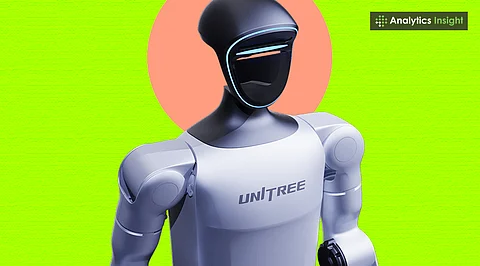

At just $5,900, Unitree R1 is the world’s most budget-friendly humanoid robot, opening doors for everyday users and developers.
R1 walks, runs, maps in 3D, responds to voice commands, and comes with an open SDK for custom development.
More than hardware, R1 marks a cultural shift, bringing humanoid robots into homes, not just labs or factories.
There are moments in tech history that permanently shift what we think is possible. July 2025 feels like one of those moments. Unitree Robotics, a company best known for making four-legged robot dogs that dart across pavement, just changed the conversation with something shockingly real and surprisingly within reach.
Let’s take a look at Unitree R1, a fully functional, bipedal humanoid robot that you can now buy for just $5,900 (approximately Rs. 5.1 lakh). It’s not a fragile lab prototype that only works under perfect conditions. This robot from Unitree is a fully operational humanoid robot that exists today, and it works effectively.
Also Read: Dreame F10 Robot Vacuum Review
It’s a 165 cm-tall, 25 kg humanoid robot packed with 26 degrees of freedom, real-time 3D mapping, voice command capabilities, and visual processing. It can walk, run, balance, map its surroundings, respond to speech, and yes, it can even do a handstand.
Beyond the technical specs, this is a developer-friendly robot. It comes with an open SDK, which means it’s built to grow and adapt. Whether it's startups experimenting with robotic assistants or educators crafting next-gen coding curricula, R1 serves as a working platform rather than a locked, limited-use gadget.
For context, Tesla’s Optimus robot is aiming for a $30,000 price point when it finally rolls out, possibly in 2026. Boston Dynamics' impressive Atlas is priced closer to $100,000 and remains confined to labs and industrial environments.
By contrast, the humanoid robot costs less than a high-end gaming laptop or a trio of flagship smartphones. It’s not a robot designed for the elite. It’s something an individual might realistically save for, similar to a motorcycle or an iPhone. This is the first time a humanoid robot has entered the consumer robotics market, not as a scientific experiment but as a practical, functional product.
Unitree’s latest product isn’t about gimmicks. It’s about integrating into daily life. Picture this:
You wake up. The robot detects movement, starts the coffee machine, hands over your glasses, and reads your schedule.
Does your child have doubts about geography? R1 helps with the answer, maybe even turning it into a fun quiz.
Grandma needs her meds from a high shelf? R1 retrieves them with ease.
Your friends drop by? This robot does a backflip just to impress.
It won’t babysit or fold laundry just yet. However, it brings us one step closer to a world where humans and robots share living spaces, not in movies, but in everyday routines.
The real story here isn’t just about affordability. It’s about access. Until now, the only people working with humanoid robots were researchers backed by million-dollar grants. With this innovation, Unitree has handed that power to indie developers, startup labs, and curious tech enthusiasts with big ideas.
This could be robotics' Xiaomi moment, the point where prices drop and opportunities expand. Think back to when smartphones became affordable. The wave of innovation that followed was unstoppable. This marvel of robotics carries that same disruptive potential.
At $5,900, this isn’t something that will fly off the shelves into every home. But that’s not the point. Unitree R1 isn’t meant to be a household staple right away. It’s a stepping stone, a working prototype for the future of human-machine coexistence.
It’s built for early adopters, those willing to explore what it means to live, work, and create with a humanoid companion nearby. The people who will shape not just the code, but the etiquette and expectations of this new relationship.
Also Read: How Robotics is Transforming Learning?
Unitree R1 is not perfect. It won’t replace your cleaning crew or serenade you with poetry, but it's real, and you can buy it.
You can code for this robot, and you can make it perform all kinds of tasks. For the first time in history, a bipedal humanoid robot isn’t locked away in a lab or staged in a keynote video. It’s ready to stand by your couch, stretching its mechanical arms, waiting for its next instruction.
